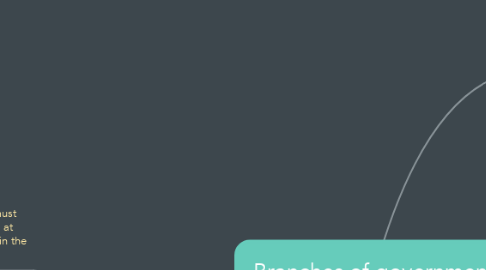
1. Executive branch
1.1. To serve as vice president, you must be a natural-born U.S. citizen be at least 35 years old, be a resident in the U.S. for at least 14 years.
1.2. Term limits , restrict the number of terms of office an officeholder may hold.
1.3. The head of the executive branch is the president of the United States, whose powers include being able to veto, or reject, a proposal for a law.
1.4. The primary duties of the class president usually include working with students to resolve problems, and informing school leaders and the student council of ideas emanating from the class.
1.4.1. The president also has the responsibility of leading class cabinet meetings and organizing student activities and events.
1.5. The Cabinet includes the Vice President and the heads of 15 executive departments.
1.5.1. The Secretaries of Agriculture, Commerce, Defense, Education, Energy, Health and Human Services, Homeland Security, Housing and Urban Development, Interior, Labor, State, Transportation, Treasury, and Veterans Affairs
2. Legislative branch
2.1. The House of Representatives and the Senate.
2.2. The Constitution requires that Members of the House be at least 25 years old, have been a U.S. citizen for at least seven years, and live in the state they represent.
2.3. 100 serve in the U.S. Senate and 435 serve in the U.S. House of Representatives. Unless you wanna count them as one for 535.
2.4. The legislative branch makes all laws, declares war, regulates interstate and foreign commerce and controls taxing and spending policies.
2.5. House of Representatives serve two year terms and are considered for reelection every even year.
2.5.1. Senators however, serve six-year terms and elections to the Senate are staggered over even years so that only about 1/3 of the Senate is up for reelection during any election.
2.6. Implied powers come from the Constitution's Elastic Clause which grants Congress power to pass any laws considered necessary and proper for effectively exercising
2.6.1. Laws enacted under the implied powers doctrine and justified by the Elastic Clause are often controversial and hotly debated.
3. Judicial branch
3.1. No age, education, job experience, or citizenship rules exist.
3.1.1. You also don’t need a law degree.
3.2. After being selected by the president, you must be approved by a simple majority vote, 51 votes of the Senate.
3.2.1. Under Article II, the President alone is empowered to nominate Supreme Court Justices and the U.S. Senate is required to confirm those nominations.
3.3. Nine Justices make up the current Supreme Court: one Chief Justice and eight Associate Justices.
3.3.1. The Honorable John G. Roberts, Jr., is the 17th Chief Justice of the United States, and there have been 102 Associate Justices.

